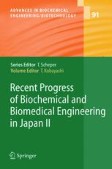Search
Search Results
-
Tracking Movement in Cell Biology
This article is an overview of techniques for measuring movement of proteins, vesicles and cells using digital image processing. Diverse techniques...
-
Taxonomy and phylogenetic diversity among the yeasts
Yeasts are among the economically and scientifically most important eukaryotic microorganisms known. At present, there are 1,500 recognized species,...
-
Metabolic Engineering
Metabolic engineering is a powerful methodology aimed at intelligently designing new biological pathways, systems, and ultimately phenotypes...
-
Cell-free Protein Synthesis Systems: Increasing their Performance and Applications
The Escherichia coli cell-free protein synthesis system can now be used for various proteins that need special requirements, such as disulfide bond...
-
Insect Chemical Defense
Research on the defensive chemistry of insects during the last decade is reviewed, with special emphasis on non-volatile compounds. The isolation and...
-
Regeneration of Articular Cartilage
Loss of articular cartilage from the ends of bones forming diarthrodial joints can be the source of profound pain and disability, and eventually lead...
-
Fluorescence Lifetime Imaging Microscopy (FLIM)
Fluorescence lifetime imaging microscopy (FLIM) is a technique to map the spatial distribution of nanosecond excited state lifetimes within...
-
Spectral Imaging and Linear Unmixing in Light Microscopy
Fluorescence microscopy is an essential tool for modern biological research. The wide range of available fluorophores and labeling techniques allows...
-
Model-based Inference of Gene Expression Dynamics from Sequence Information
A dynamic model of prokaryotic gene expression is developed that makes considerable use of gene sequence information. The main contribution arises...
-
Bioprocess Monitoring Using Near-Infrared Spectroscopy
Near-infrared spectroscopy (NIR) is a nondestructive analytical technique that has been used for simultaneous prediction of the concentrations of...
-
Metabolic Flux Analysis Based on 13C-Labeling Experiments and Integration of the Information with Gene and Protein Expression Patterns
The recent progress on metabolic systems engineering was reviewed, in particular focusing on the metabolic flux analysis (MFA) based on the...
-
Transgenic Birds for the Production of Recombinant Proteins
Transgenic birds were expected to be an excellent transgenic bioreactor for the production of recombinant pharmaceutical proteins. However, the only...
-
Vertebrate Limb Regeneration
In this chapter, we have touched upon some of the key processes of vertebrate limb regeneration from the formation of the wound epithelium to pattern...
-
Mammalian Fetal Organ Regeneration
The develo** fetus has the remarkable ability to heal dermal skin wounds by regenerating normal epidermis and dermis with restoration of the...
-
Regenerative Capacity and the Develo** Immune System
Many components of the vertebrate immune system have evolved with dual, interrelated functions of both protecting injured tissues from infection and...
-
Tissue Engineering Strategies for Bone Regeneration
Bone loss due to trauma or disease is an increasingly serious health problem. Current clinical treatments for critical-sized defects are problematic...
-
Stem Cells in CNS and Cardiac Regeneration
The central nervous system (CNS) and the heart muscle regenerate poorly after injury, yet evidence is mounting that both harbor cells capable of...
-
Comparative genomics and gene finding in fungi -- Supplement
Online Supplement to Chapter 1
-
Present Status of Antifouling Systems in Japan: Tributyltin Substitutes in Japan
An international conference held by the International Maritime Organization in October 2001 adopted an “International convention on the control of...
-
New Trends in Sample Preparation Methods for the Determination of Organotin Compounds in Marine Matrices
Tributyltin still remains a major issue for the marine environment and its determination is mandatory by legislation in several countries. As for...
